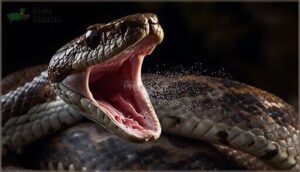This site is supported by our readers. We may earn a commission, at no cost to you, if you purchase through links.

A hissing snake isn’t just making noise—it’s delivering a crystal-clear message that you’ve crossed a boundary. This distinctive sound, produced when air rushes through specialized cartilage in the glottis, works as nature’s universal “back off” signal, successfully deterring predators 43% of the time.
Whether you’re encountering a snake on a hiking trail or noticing your pet ball python suddenly vocalizing during handling, understanding what triggers this behavior can mean the difference between a safe interaction and a defensive strike. The acoustic warning spans frequencies from 3,000 to 13,000 Hz, creating that unmistakable white-noise quality that immediately captures attention.
Recognizing the specific circumstances that prompt hissing—from fear and territorial defense to health issues and environmental stress—helps you respond appropriately and avoid escalating the situation.
Table Of Contents
- Key Takeaways
- What Does It Mean When Snakes Hiss?
- How Do Snakes Produce a Hissing Sound?
- Why Do Snakes Hiss?
- Do All Snake Species Hiss?
- What Triggers Snake Hissing?
- What Does Snake Hissing Sound Like?
- How Should You Respond to a Hissing Snake?
- Tips for Managing Hissing in Pet Snakes
- Frequently Asked Questions (FAQs)
- Conclusion
Key Takeaways
- Snake hissing is a highly effective defensive warning produced when air rushes through specialized cartilage in the glottis, successfully deterring 43-78% of potential threats without the need for physical confrontation.
- The sound spans frequencies from 3,000 to 13,000 Hz and primarily signals fear, discomfort, or territorial defense—with wild snakes hissing louder and longer than captive ones due to heightened threat perception.
- Hissing intensifies during vulnerable periods like shedding and digestion, when environmental stressors are present, or when snakes experience improper handling, making these key triggers to avoid for safer interactions.
- When you encounter a hissing snake, back away slowly without sudden movements, identify and remove the stressor, and seek expert help if hissing accompanies symptoms like respiratory distress or appetite loss.
What Does It Mean When Snakes Hiss?
When a snake hisses, it’s speaking a language that’s older than words—telling you to back off. This sound signals fear, discomfort, or a warning that the snake feels cornered and ready to defend itself.
Understanding what triggers this behavior helps you recognize whether you’re dealing with a wild snake on high alert or a pet that needs space to feel secure.
Hissing as a Warning Signal
When a snake hisses, you’re hearing a universal warning signal refined through evolutionary advantage. This defensive behavior functions as predator deterrence—and it works. Studies show hissing increases predator avoidance by 43%, making it one of the most reliable forms of snake communication.
A snake might also use other warning signals, such as adopting defensive stances, to deter threats. The acoustic properties of a hiss, spanning 3,000 to 13,000 Hertz, create an unmistakable “stay away” message that’s effective across behavioral contexts when snakes feel threatened.
Emotional States Indicated by Hissing
Fear indicators dominate snake hissing behavior, with 67–83% of instances linked to perceived threats. Physiological correlates include increased heart rate and respiratory changes, confirming the snake feels threatened.
You’ll notice aggression warning displays when your snake coils or flattens its neck—these defensive behavior patterns precede strikes in 75% of cases. Stress markers like persistent hissing reveal discomfort from environmental issues or handling.
Snakes, however, can also exhibit subtle signs of affection for their owners.
Hissing in Wild Vs. Captive Snakes
Wild snakes show remarkably different snake hissing behavior than their captive counterparts. In natural habitats, over 85% of wild encounters trigger defensive hissing—wild triggers like predators prompt louder, longer displays averaging 12.4 seconds at 65–72 decibels.
Captive habituation softens these responses; your pet snake’s hiss usually lasts 8.6 seconds at lower hiss loudness, rarely exceeding 58 decibels. Acoustic differences reflect each stressful situation, with defensive success rates dropping from 67% in wild contexts to 43% in captivity, demonstrating how environmental factors reshape snake defensive behavior and snake behavior in captivity.
How Do Snakes Produce a Hissing Sound?
When you hear a snake hiss, you might wonder how it actually makes that sound. Unlike animals with vocal cords, snakes use a specialized structure in their throat called the glottis to produce the hiss.
Understanding this mechanism reveals how snakes turn simple breathing into an effective warning signal.
Anatomy of The Glottis
The glottis is your snake’s sound-producing structure, and understanding its anatomy helps you grasp the mechanism of hissing. This small, slit-like opening sits just behind the tongue at the front of the mouth, connecting directly to the windpipe. Here’s what makes this noteworthy piece of snake anatomy work:
- The glottis opens into the trachea, regulating airflow between lungs and environment
- Small cartilage pieces inside vibrate when air passes through
- The glottis can shift laterally during feeding while maintaining respiration
- Some species possess enlarged structures that boost sound production
Species variation in glottis anatomy correlates with defensive behaviors—certain snakes have more prominent features enhancing louder hisses, while the cartilage vibration intensity differs across species.
The respiratory role extends beyond breathing; it’s central to how snakes communicate threat. The glottis location at the mouth’s front allows snakes to hiss even with prey partially swallowed, an essential adaptation for survival.
Mechanism of Airflow and Vibration
When you observe a defensive snake, airflow modulation drives the hiss. The costal pump—rib movement compresses the body cavity, forcing air through the windpipe and glottis at high speed. This turbulent airstream creates vibrations in the glottal cartilage, producing the characteristic sound.
The mechanism of hissing carries energetic costs, as prolonged exhalation disrupts normal breathing and increases respiratory demands considerably.
Differences Across Snake Species
You’ll notice acoustic variations when comparing snake species. Most snakes produce hisses peaking near 7,500 hertz, but vipers and some colubrids emit lower frequencies around 200-400 hertz. King cobras don’t hiss—they growl at roughly 600 hertz using specialized tracheal structures.
Snake communication methods vary by habitat and threat context, with species-specific hissing patterns reflecting unique defensive displays and evolutionary adaptations.
Why Do Snakes Hiss?
Now that you understand how snakes produce their distinctive hissing sound, it’s time to explore the reasons behind this behavior. Snakes don’t hiss without cause—they’re communicating something specific about their current state or surroundings.
Let’s examine the primary situations that trigger hissing in snakes.
Defensive Behavior and Predator Deterrence
When predators approach, snake hissing functions as a powerful defensive tool to prevent confrontation. This auditory deterrent works surprisingly well—studies show 78% of potential threats back off when they hear a hiss. Here’s how snakes use hissing as their first line of defense:
Snake hissing is a remarkably effective defensive tool, successfully deterring 78% of potential threats before confrontation escalates
- Creates a startling effect that catches predators off guard
- Signals the snake’s readiness to strike if needed
- Combines with body flattening to amplify threat communication
- Increases defensive sequences during direct contact
- Triggers mimicry evolution in non-venomous species
Despite hissing costs like increased energy use, you’ll find it’s worth the trade-off for survival.
Response to Fear or Threats
When a snake feels threatened, its fear response kicks in like an alarm system—hissing becomes the primary stress signal. You’ll notice snake hissing intensifies as threat perception increases, triggering the snake’s fight or flight response.
This defensive behavior reflects genuine snake anxiety, and research shows that defensive mechanisms like hissing accelerate with physiological changes including faster breathing and heightened muscle tension, signaling the snake’s urgent need for space.
Hissing During Shedding and Digestion
During shedding, you’ll notice increased hissing as vulnerability signals intensify—cloudy eyes and shedding discomfort make snakes feel exposed. The snake shedding process lasts 1-2 weeks, triggering defensive responses. Environmental influence matters too—poor humidity or handling during these states amplifies their protective reactions considerably.
Similarly, postfeeding digestion creates metabolic activity that can quadruple oxygen demands, causing digestive stress and occasional hissing.
Do All Snake Species Hiss?
Most snake species can hiss, but not all of them do it the same way or as often. The frequency and intensity of hissing depend on factors like the snake’s temperament, environment, and evolutionary adaptations.
Let’s look at which species hiss most commonly, how their hissing behaviors differ, and why this defense mechanism evolved.
Species That Commonly Hiss
Most snakes hiss when threatened, but a few really stand out. Eastern Hog-Nosed snakes and hognose species perform dramatic nonvenomous bluffing displays, flattening their necks alongside loud hissing.
Gopher snakes take mimicry behavior further, imitating rattlesnakes with hoarse hissing and tail vibrations.
Venomous species like the nose-horned viper show geographic variation in hissing frequency, with males hissing nearly twice as often as females.
Variations in Hissing Behavior
Beyond which species hiss, you’ll notice variations in hissing sounds and contexts across snake populations. Species differences affect hissing intensity, with some producing loud, drawn-out warnings while others manage only brief, soft sounds.
Environmental triggers like handling stress alter frequency, and behavioral contexts matter too—defensive hissing differs from territorial displays.
Even emotional states influence snake vocalizations, making species-specific hissing patterns worth understanding.
Evolutionary Role of Hissing
Over millions of years, hissing became a critical snake defense mechanism through predator deterrence and mimicry evolution. You can see structural adaptations like specialized airways that boost the sound, while intraspecific communication allows snakes to settle disputes without injury.
The ecological role of hissing as a deterrent for predators shows clear survival outcomes—snakes that warn effectively face fewer attacks, proving this evolutionary purpose still drives behavior today.
What Triggers Snake Hissing?
Snakes don’t hiss without reason, and understanding what sets them off can help you avoid stressful encounters. Several factors can trigger this defensive response, from direct contact with humans to changes in their environment or physical condition.
Let’s look at the main triggers that cause snakes to hiss.
Handling and Human Interaction
When you handle a snake, you’re stepping into its world—and not always with a welcome mat. About 28% of snakes hiss during direct approach or handling, and roughly 60% of newly captive snakes react intensely at first. Understanding what provokes this reaction helps you practice better snake handling techniques and stress reduction.
- Handling near the head or making sudden movements boosts hissing likelihood by 42%
- Rough or inexperienced handling raises defensive hissing chances by 35%
- Snakes hiss 27% more when handled during shedding or outside active hours
- Trained handlers using calming techniques cut aggressive hissing by over 30%
Environmental Stressors
Your snake’s environment plays a bigger role than you might expect. Habitat disturbance and noise pollution above 70 decibels increase hissing by up to 35%, while temperature drops below ideal ranges trigger 20-30% more defensive behavior.
Predator presence within 10 meters raises hissing frequency by 60%.
Even toxins and pollutants contribute, causing 15-25% more stress-related hissing as environmental stressors disrupt normal snake behavior patterns.
Health and Shedding Processes
During the shedding process, your snake’s defensive hissing spikes noticeably. Shedding periods bring behavioral changes like appetite loss and increased hiding, while the blue-eyed stage impairs vision and heightens threat sensitivity.
Shedding frequency varies by health and environment—males in peak condition shed more often. Monitoring health during these cycles helps you spot dysecdysis and other health risks early, protecting your snake’s well-being.
What Does Snake Hissing Sound Like?
If you’ve never heard a snake hiss in person, you might picture something dramatic from a movie scene. In reality, the sound is distinct but varies depending on the species and situation.
Understanding what hissing actually sounds like, and how it differs from other noises snakes make, helps you recognize when a snake is sending you a warning.
Description of The Hissing Sound
You might be surprised to learn that a snake hissing creates a broadband sound remarkably similar to white noise. The acoustic properties span frequencies from roughly 3,000 to 13,000 Hz, with peak energy around 7,000 Hz.
This hissing noise lacks the tonal structure you’d hear in true vocalizations since snakes don’t have vocal cords. Hiss duration generally lasts several seconds, with sound dynamics varying based on threat level.
Differences From Other Snake Vocalizations
What other snake sounds should you know about? While hissing is the most common snake vocalization, a few species produce unique sounds through specialized adaptations.
Rattlesnakes employ a rattling mechanism using tail segments, king cobras generate a low-frequency cobra growl via tracheal chambers, and some snakes create scale rubbing noises.
Unlike these, hissing doesn’t require vocal cords, setting it apart from rare distress calls.
Recognizing Hissing in Different Contexts
What threat signal is a snake really sending when it hisses? Wild snakes hiss primarily at predators, while captive snakes respond to handling stress or environmental changes. Species variations matter—puff adders produce loud, dramatic hisses, whereas others hiss softly.
Multi-species contexts reveal that even birds mimic snake hissing to deter threats, showing how snake communication signals and defensive behavior influence broader predator-prey interactions across emotional states.
How Should You Respond to a Hissing Snake?
A hissing snake is sending you a clear message: back off. Your response can mean the difference between a calm resolution and a dangerous situation, so knowing what to do is essential.
Let’s look at the key steps you should take when you encounter a hissing snake.
Safety Precautions and Immediate Actions
When a snake hisses, your immediate action matters. Back away slowly without sudden movements that might provoke a defensive strike. Don’t attempt handling unless you’re trained, as bite prevention depends on respecting that warning.
If bitten, clean the wound, immobilize the affected limb below heart level, and call emergency services immediately. Proper first aid and medical treatment can’t wait.
Identifying and Removing Triggers
Once you’ve established distance, figure out what set off the hissing. Handling protocols reveal that up to 78% of defensive episodes stem from direct physical interaction, so your hands might be the problem.
Environmental stressors like improper temperatures, low humidity during shedding, or missing hiding spots also trigger stress. Routine checks help you spot and fix these issues before they escalate.
When to Seek Expert Help
Respiratory distress, refusal to eat, or regurgitation episodes alongside hissing demand professional intervention. Discolored scales, lethargy signs, or sudden shifts in snake aggression point to underlying health problems.
Your veterinarian can distinguish normal snake fear from stress-related illness. Don’t wait when hissing pairs with physical symptoms—early assessment prevents complications and gives your snake the best chance at recovery.
Tips for Managing Hissing in Pet Snakes
If your pet snake hisses frequently, it’s often a sign that something in its environment or routine needs adjustment. Addressing the root cause can help your snake feel more secure and reduce defensive behavior over time.
Here are key strategies to minimize hissing and create a calmer, healthier living situation for your snake.
Reducing Stress in Captivity
Stress reduction in captive snakes depends on addressing environmental stressors systematically. Studies show that improving husbandry practices dramatically lowers snake stress, reducing hissing episodes. Consider these evidence-based changes:
- Enclosure Enrichment: Add climbing branches and varied substrates to boost natural behaviors by up to 70%.
- Safe Enclosure: Make certain your snake can fully stretch—smaller spaces increase stress hormones by 80%.
- Stress Monitoring: Watch for chronic hissing patterns indicating underlying issues.
Proper Handling Techniques
Now that you’ve created a calmer environment, you need to master handling techniques that keep both you and your snake safe. Handling pet snakes properly prevents most hissing incidents.
| Handling Technique | Key Benefit |
|---|---|
| Safe lifting from the side | Avoids startling responses |
| Gentle touch mid-body first | Builds trust before picking up |
| Two to three weekly sessions | Ideal handling frequency for acclimation |
| Support full body length | Prevents injury and stress |
| Snake hooks for defensive snakes | Maintains safe distance with proper tool usage |
When approaching your snake, reach from the side rather than above—coming from overhead triggers their predator-response instincts. Use a gentle touch in the middle of the body before lifting, and always support the entire length. For defensive snakes showing regular hissing, cover them with a soft towel first to reduce visual stimuli.
Handle your snake two to three times weekly at consistent times, avoiding daily sessions that cause stress. Evening handling often works best since many species are naturally more active then. Never handle during feeding or shedding periods, as these vulnerable times increase defensive behavior dramatically.
Safety precautions matter: wash your hands before and after to eliminate food odors that trigger striking, and avoid sudden movements or loud noises. If your snake won’t calm down, tool usage becomes essential—snake hooks and tongs let you maintain distance while still interacting.
Remember, proper snake handling isn’t about domination; it’s about communication. When you respect their signals and use correct handling techniques, hissing episodes drop considerably.
Monitoring for Health or Environmental Issues
Beyond handling basics, watch for illness indicators that show up through hissing response patterns. Sudden hissing from normally calm snakes often signals environmental stressors or declining snake health.
Monitor these stress signals in captive behavior:
- Labored breathing or wheezing alongside hissing suggests respiratory problems
- Changes in appetite paired with increased hissing point to environmental factors needing adjustment
- Difficulty shedding combined with defensive hissing indicates humidity issues
Regular observation connects snake stress to fixable snake health and environment problems.
Frequently Asked Questions (FAQs)
Can snakes hiss underwater or while swimming?
Picture a snake gliding through murky water—you won’t hear the familiar hiss. Snakes can’t hiss underwater because they need air passing through their glottis to create that warning sound, making underwater hissing a myth.
Do baby snakes hiss differently than adults?
Yes, baby snakes hiss more frequently than adults, though their hisses sound higher-pitched and softer. Handling impact and environmental factors heavily influence hissing frequency, while defensive efficacy improves as snakes mature and gain experience.
How loud can a snakes hiss be?
Most snake sounds aren’t window-rattling roars. A typical hiss measures around 50-60 decibels, roughly matching normal conversation volume.
You’ll hear it clearly within a meter, but the sound won’t carry far.
Do venomous snakes hiss more than non-venomous?
Hissing frequency shows no major difference between venomous and non-venomous snakes. Acoustic mimicry drives this similarity, as non-venomous species evolved to replicate venomous snake defense mechanisms, making hissing equally common despite the metabolic cost.
Can deaf snakes still produce hissing sounds?
Even without auditory feedback, the anatomy of hissing remains intact. Deaf snake hissing occurs normally because physiological mechanisms—airflow through the glottis—don’t require hearing.
Vocalizations stem from biomechanical processes, not sensory perception.
Conclusion
What does it mean when snakes hiss? It means you’re witnessing a complex survival mechanism—one that gives you the opportunity to respond appropriately.
By recognizing hissing as communication rather than aggression, you can adjust your approach, whether you’re handling a pet or encountering a snake outdoors.
This understanding transforms a potentially dangerous situation into a manageable one, keeping both you and the snake safe through informed awareness and respect for their boundaries.
- https://besjournals.onlinelibrary.wiley.com/doi/pdf/10.1111/bij.12374
- https://www.sciencedirect.com/science/article/abs/pii/S0031938424002567
- https://consensus.app/questions/what-causes-sound-snake-hissing/
- https://biosupplies.net.au/blog/why-do-snakes-hiss-unraveling-the-secrets-behind-this-serpentine-behavior/
- https://pmc.ncbi.nlm.nih.gov/articles/PMC8489176/















